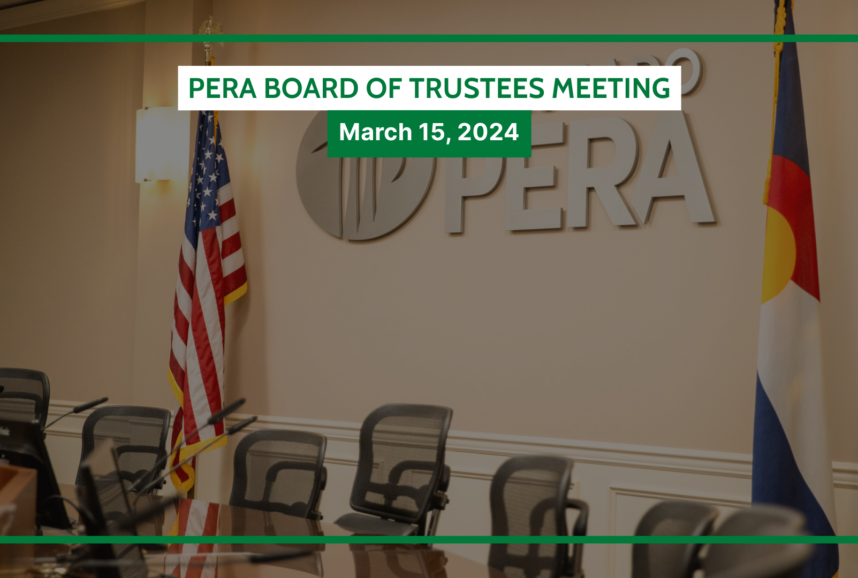At its September meeting, the PERA Board of Trustees kicked off an important analysis of PERA’s investment portfolio and strategy. Known as an asset/liability study, the project will help Trustees determine whether changes are needed to PERA’s mix of investments.
The importance of asset allocation
PERA’s strategic asset allocation — the mix of stocks, bonds, and other investments that make up the portfolio — is the most important factor that drives the fund’s investment performance. PERA needs to be able to pay monthly benefits to current and future retirees for decades to come, so it’s important we have a portfolio that supports that mission.
Each category of assets serves a distinct purpose, with the result being a diversified portfolio that’s meant to withstand ups and downs in the market and produce returns over the course of decades. Read more about the role each asset class plays in our series, Asset Classes Explained.
The Board is responsible for determining the asset allocation, which staff then implement. The PERA Board typically conducts an asset/liability every four or five years and adopted PERA’s current asset allocation following the last study in 2019. That study resulted in the following targets:
| Asset class | Long-term target | Permissible range |
| Global Equity | 54.0% | 48% to 60% |
| Fixed Income | 23.0% | 18% to 28% |
| Private Equity | 8.5% | 4% to 13% |
| Real Estate | 8.5% | 4% to 13% |
| Alternatives | 6.0% | 0% to 12% |
| Cash | 0.0% | 0% to 3% |
The actual percentages in each asset class can vary based on market fluctuations, but must fall within the allowable range set by the Board. This ensures PERA’s portfolio is in line with the Board’s goals and strategy.
Through the process of regular asset/liability studies, the Board has made incremental adjustments to PERA’s asset allocation over time to achieve an annualized return of 8.3% over the past 30 years.
What is an asset/liability study?
Over the next several months, PERA’s investment consultants will work with staff and the Board to conduct the asset/liability study. It’s an in-depth analysis that looks at various factors, including:
- The relationship between assets (investments) and liabilities (benefits owed): The study will involve modeling various scenarios over time to see how different investment decisions could impact the plan’s funding long-term. Are there any asset mixes that are more likely to help PERA reach its funding goals?
- The fund’s risk tolerance: How much risk can the fund take on appropriately? Should the portfolio include more potentially volatile investments like stocks, or more lower-risk investments like bonds? Increasing the amount of risk can bring the potential for higher returns while lowering risk can protect the fund from losses in down markets.
- Market conditions: Since PERA is a long-term investor, it’s important to look at what the future might hold. While the Board doesn’t have a crystal ball, it will work with experts to forecast market conditions for the various asset classes to understand the potential returns over the next several decades.
The study will help the Board determine if the current mix of investments is appropriate to help PERA reach its funding goals, or if changes are needed to adjust the level of risk in the portfolio. If the Board decides to make changes to the strategic asset allocation, staff will work to modify the portfolio accordingly.
The Board expects to dive deeper into the details at its November meeting, with the possibility of finalizing the study as soon as the spring.
Global equityA type of investment that includes publicly traded stocks in companies based in the United States and abroad.Asset classesA category of similar investments. Common asset classes include global equity (such as publicly traded stocks), real estate, and cash.AlternativesA broad category of investments that don’t fit into traditional categories like stocks and bonds.Asset allocationAn investor’s mix of stocks, bonds, and other investments. PERA’s strategic asset allocation is set by the PERA Board of Trustees.Private equityA type of investment in which investors purchase shares of a company that is not traded on a public stock exchange.Fixed incomeA type of investment that pays investors a fixed rate of interest over a set period of time. Bonds are a common type of fixed income investment.Asset classA category of similar investments. Common asset classes include global equity (such as publicly traded stocks), real estate, and cash.Asset classA category of similar investments. Common asset classes include global equity (such as publicly traded stocks), real estate, and cash.Asset classA category of similar investments. Common asset classes include global equity (such as publicly traded stocks), real estate, and cash.





Thanks for all the work.
Anything new on repealing WEP?
Hi Dale, sorry you missed it. We did include an update in yesterday’s newsletter. You can read the latest here: https://peraontheissues.com/an-update-on-2023-wep-gpo-legislation/ and if you haven’t subscribed, you can do so here: https://peraontheissues.com/subscribe/
ASLEEP AT THE WHEEL FOR FOUR YEARS?!
The Board has been sitting on its hands since the pandemic, through the fed’s rate hikes, while geo-political conditions have become more destabilizing. They boast of an annualized return of 8.3% over the last three decades, in order to cling to unrealistic future expectations of returns over 7%; despite last year’s loss of over 13%; and even after impoverishing retirees by eliminating COLAs, raising eligibility requirements along with decreased benefits, and foisting contribution increases on workers (oh sorry, it was legislators who did those terrible things to raid our pensions in the name of saving us through “shared sacrifice”).
I suspect lobbyists for Vulture Capitalists have already lobbied PERA Board & Staff (PERA B.S.) to accept “private equity” as a financial panacea and will whip the politicians in line to enrich another undeserving group with money ripped primarily from the hands of retirees.
I’d love to be proved wrong when the Asset/Liability study comes back, but I see the powers-that-be falling lock step behind a recommendation to expand “private equity” investments in the portfolio.
In closing, thanks for another self-promoting article that ignores ongoing theft against beneficiaries… it’s everything I expect from PERA B.S.
Thank you so much GM Santo!
I would add that the PERA BS does indicate that prior to the State of Colorado help, PERA BS lost 30 Billion!!! …. and PERA does not show how much is invested in ESG [which stands for Environmental, Social, and Governance. Investors are increasingly applying these !non-financial factors! (omg the worst reason for investing!!) as part of their analysis process to identify material risks and growth opportunities.]
Hi Davis, we have covered ESG and PERA’s approach here: https://peraontheissues.com/esg-making-sense-of-alphabet-soup/. To be clear, we value financial sustainability first and foremost, and we do not invest to suit the personal beliefs of any one person or entity. Our investment staff consider a wide variety of financially relevant factors when deciding what to include in the portfolio, including some that can be labeled as ESG-related. We do not have any ESG-centric investment requirements and we do not screen investments on any specific ESG criteria. We invite you to read our Investment Stewardship Report to learn more: https://www.copera.org/investment-stewardship